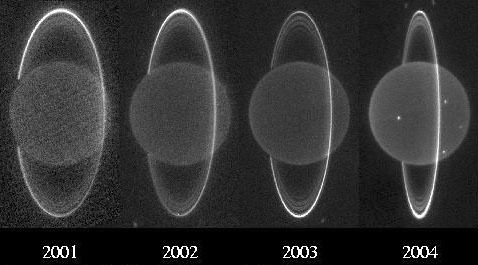Emily Lakdawalla • May 06, 2006
OPAG, Day 1: Uranus equinox is coming up
Heidi Hammel gave a brief but spirited presentation designed to wake up the audience to the fact that Uranus is fast approaching its equinox, an event that will happen on December 7, 2007. The approaching springtime for the northern hemisphere has already produced dramatic changes in Uranus' cloud features. (See "No Longer Boring: 'Fireworks' and Other Surprises at Uranus Spotted Through Adaptive Optics.") Heidi pointed out that Uranian equinoxes are quite rare; the last one was in 1965, and the next one will not be until 2049. (Curt Niebur joked that "with that lead time I can get it in the NASA budget.")
There was a workshop for two days in the middle of this week of an international group of planetary astronomers talking about what the Uranus equinox observing campaign should be: science objectives, measurement objectives, which telescopes to request time on for what sorts of observations, that sorts of thing. One of the most interesting observational events, which I hadn't thought about before, is that when Earth crosses Uranus' ring plane (which it will do twice in 2007 and once in 2008, because Earth's orbit is slightly tilted with respect to Uranus' orbit -- ring plane crossings do generally happen three times for every giant planet equinox), we will get to observe "mutual events" of Uranus' satellites. Now, I've written a lot about the nifty mutual event movies that Cassini has made by watching one Saturnian moon passes in front of another. The movies that ground-based telescopes will make of the much more distant Uranian system will not be visually spectacular in that way; they'll just be points of light.
However, by watching how one satellite dims the light of another, and then spending a ridiculous amount of computer time crunching that light curve into a computer model, they can figure out the large-scale patterns of brightness and darkness on the surfaces of these bodies. This is exactly how scientists have produced "maps" of Pluto and Charon, by observing the light curves from their mutual events. And remember that because Voyager passed by Uranus when it was near its southern summer solstice, half of the entire globes of all of Uranus' satellites were in winter darkness, their surfaces nearly invisible to Voyager's cameras. Our maps of these worlds have virtually no detail in their northern hemispheres. Observations of these mutual events will let scientists make the first maps of the northern hemispheres of Miranda, Ariel, Umbriel, Titania, and Oberon. And without any plans for a return to Uranus over the next fifty years or more, these observations are as good as it's going to get in the professional lifetimes of all active planetary scientists.
The punch line of Heidi's presentation was to formally request OPAG to draft a letter to NASA expressing support for the next two years of ground-based Uranus observation surrounding this equinox event; such a letter will help the planetary astronomy community win telescope time and grant funding to put out an extra effort to observe Uranus during this unique period. Nobody in the room had any objection; it's going to be a really cool few years for Uranus science.

Let’s Go Beyond The Horizon
Every success in space exploration is the result of the community of space enthusiasts, like you, who believe it is important. You can help usher in the next great era of space exploration with your gift today.
Donate Today

 Explore Worlds
Explore Worlds Find Life
Find Life Defend Earth
Defend Earth

